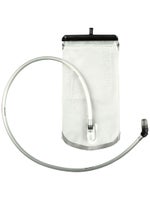LEARNING CENTER: HOW TO
How to Clean a Hydration Pack
Keeping your reservoir and hydration pack clean will extend the life of the item. If not cleaned on a regular basis, bladders can grow mold or mildew, while the pack itself can develop unpleasant odors and unsightly stains.
Cleaning the hydration bladder / reservoir

Reservoir Tube: Reservoir tubes can be cleaned by simply disconnecting the tube from the body of the bladder by pressing the quick disconnect button, or pulling the tube from the housing, if the quick disconnect option is not available for your bladder. Clean the bite valve with warm water and mild soap or detergent, then run hot tap water through the tube, pressing the bite valve to allow the water to flow all the way through for a few seconds. Drain the tube and set aside to dry.

Top-fill Reservoir: Cleaning the reservoir itself will depend on the brand. Bladders with a top-fill slide seal design can be flipped inside out for easy cleaning. To do this, reach inside the reservoir and grasp the inside bottom firmly, then pull the inside out, flipping the plastic tracks for the slide seal last. Once the bladder is inside out, it can be cleaned with warm, soapy water and then rinsed thoroughly with cool tap water. To dry, prop the bladder open and let it sit upside down to drain. Or, slide-seal bladders can be washed in the dishwasher (top rack only).
Cap-Fill Reservoir: To clean a reservoir with a front-fill cap design, it will be necessary to use a long handled brush and scrub out the inside with soapy water, then rinse thoroughly. Allow to drain and dry completely.
Tip: we suggest drying your reservoir by placing it upside-down on top of a portable paper towel holder to keep it open and inverted, or use salad tongs to keep it open while it dries.
Shop all Hydration Bladders / Reservoirs
Keep in mind it's best to clean the reservoir after every use, or at least rinse it out and let it air dry. This is especially important if you use any hydration beverage besides water. It's not always feasible to clean and dry it every time, however, and there are a couple of methods commonly used for cleaning and sanitizing, should mold or mildew occur. Fill the bladder with warm water and half a teaspoon of bleach, two tablespoons of baking soda, or two cups of white vinegar. Close the reservoir and let the mixture sit for about 30 minutes, then flush and rinse very well and dry thoroughly.
Removing a plastic taste from the hydration bladder
You may notice a slight (or sometimes not-so-slight) plastic taste coming from your reservoir or tube, especially when it's new. This is pretty normal, and can be fixed easily. Just disconnect the hose, squeeze the juice of a whole lemon into the bladder, fill about ¾ full of water and seal it up. Place the filled reservoir into the freezer and freeze completely. The next day, remove the bladder, let thaw, and then drain the lemony water. Enjoy your fresh tasting water on your next run!
Maintenance Tip: Keeping the Quick Disconnect from sticking
If your reservoir contains Plug-N-Play technology, or any quick disconnect mechanism, you might find it getting harder to disconnect over time. That's because these mechanisms need a little lubrication every so often. Don't use olive oil, coconut oil, or other cooking oils because they can cause the seal to swell and make it even more difficult to disconnect the hose. It's recommended to use glycerin, silicone, or pure bees wax to lubricate the rubber O-ring on the connector.
Cleaning the hydration pack
Most hydration pack manufacturers agree that a pack shouldn't be washed in the washing machine. The best way to keep your pack clean is to wipe the dirty area down with a damp cloth to remove dirt or grime. If a deeper cleaning is required, hand-wash the pack in cool water with a mild soap or detergent. Rinse the pack thoroughly and let it air dry.

